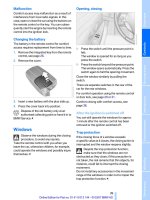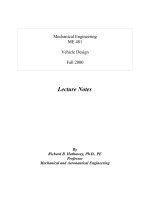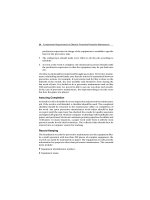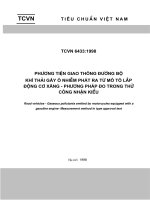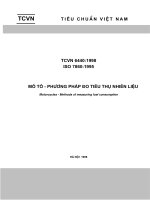Land Transport Rule: Vehicle Repair 1998 pptx
Bạn đang xem bản rút gọn của tài liệu. Xem và tải ngay bản đầy đủ của tài liệu tại đây (179.24 KB, 6 trang )
Land Transport Rule: Vehicle Repair 1998
Rule 34001
Part 1
Rule requirements 1
Section 1
Application 1
1.1 Title 1
1.2 Scope of the rule 1
1.3 Date when rule comes into force 1
Section 2
Repair requirements 2
2.1 General safety requirements 2
2.2 Repair methods 2
Section 3
Responsibilities 2
3.1 Responsibilities of repairers 2
3.2 Functions and powers of the [Agency] 2
Part 2
Definitions 2
Part 3
Schedules 5
Schedule 1
Acts, regulations and rules 5
Objective of the rule
Land Transport Rule: Vehicle Repair 1998 sets a standard for repair for vehicles and requires repairers to use suitable methods in attaining
that standard. The rule applies to all repairs and to all vehicles and includes structural, mechanical and electrical repair.
The standard for repair is that the vehicle, its structure, systems, components and equipment must be restored to “safe tolerance” of their
state when manufactured. This includes meeting the requirements specified in the Acts, regulations and rules listed in Schedule 1. The
methods of repair depend on factors such as the class and make of the vehicle, the vehicle standards which apply, and the manufacturer's
specifications.
Although the rule imposes a duty on repairers to comply, it does not state any specific mechanisms to ensure compliance. The only
applicable compliance mechanism, at present, is provided in Land Transport Rule: Vehicle Standards Compliance 1998. This provides
for repair certifiers to inspect and certify repairs following corrosion or structural damage which would adversely affect a motor vehicle's
safety performance in the following situations:
•
before a vehicle can be registered in New Zealand;
•
if a vehicle has been deregistered in New Zealand and repaired, before it can be reregistered.
Extent of consultation
Work on the Vehicle Repair Rule (previously entitled Vehicle Standards Compliance (Repair)) was initiated in early 1993 with a call
for industry suggestions on what the rule should contain and achieve. A working party, comprising representatives from the insurance
industry and from the vehicle repair, manufacturing, importing and in-service inspection industries, was established to discuss the
proposed rule in June 1993. It was initially convened by the Land Transport Safety Authority (LTSA) but was subsequently run by its
own convenor with the LTSA as a participant.
In 1995 an independent technical writer was commissioned to produce what was in effect the preliminary (red) draft of the rule, although
it focussed only on structural repair to light motor vehicles. The working party discussed these proposals for some time but consensus
could not be achieved on all relevant points.
The scope of the rule was extended to cover all vehicles and all repairs. A yellow draft was issued for public consultation in December
1997, together with the yellow draft of the Vehicle Standards Compliance (Certification) Rule, which then became the Vehicle Standards
Compliance Rule.
The availability of the drafts was publicised in metropolitan newspapers, the New Zealand Gazette, Te Maori News and the Rural
Bulletin. More than 700 copies of each draft rule were sent out during the consultation period which ended on 13 February 1998. This
provided the opportunity to consult with the wider repair industry. Some of the 38 submissions commented on the two rules separately,
while others commented on repair issues as part of their submissions on the Vehicle Standards Compliance (Certification) Rule.
The issues identified in the submissions were addressed in redrafting the rule which was then circulated to a limited number of key
groups. Ten submissions were received and the remaining issues addressed.
Commencement
Following redrafting of the rule at the end of the consultation period, and after final scrutiny by interested Government departments, the
draft rule was referred to the Minister of Transport who signed it into law on 18 December 1998. The rule comes into force on 1 March
1999.
Part 1
Rule requirements
(r 1.1 to r 3.2)
Section 1
Application
1.1 Title
This rule is to be cited as Land Transport Rule: Vehicle Repair 1998.
1.2 Scope of the rule
1.2(1) This rule applies to all motor vehicles and all vehicles of the classes specified in Table A in Part 2 of this rule, irrespective
of the date of registration of the vehicle in New Zealand, or the date of manufacture of the vehicle.
1.2(2) This rule applies to repairs that could affect the safety performance of a vehicle, its structure, systems, components or
equipment.
1.3 Date when rule comes into force
This rule comes into force on 1 March 1999.
Brookers Online 1
Section 2 Land Transport Rule: Vehicle Repair 1998
Section 2
Repair requirements
2.1 General safety requirements
2.1(1) A repair to a vehicle, its structure, systems, components or equipment, must restore the damaged or worn vehicle, structure,
system, component or equipment so that they are within safe tolerance of the state of the vehicle, structure, system,
component or equipment when manufactured.
2.1(2) If the vehicle has been certified as a modified vehicle, the repair must restore the vehicle, structure, system, component
or equipment so that the vehicle is within safe tolerance of its state when certified as a modified vehicle.
2.2 Repair methods
2.2(1) In repairing a vehicle to comply with 2.1, a repairer must use a suitable repair method that takes into account the following:
(a) the date of manufacture of the vehicle;
(b) the class, make and other relevant characteristics of the vehicle;
(c) the approved vehicle standards with which the vehicle is required to comply;
(d) the existence of relevant manufacturers' recommendations and alternative methods;
(e) the material specifications used for construction of the vehicle, structure, systems, components or equipment;
(f) the compatibility of the intended repair process with materials specifications
New and used replacement systems, components and equipment
2.2(2) A repairer must use systems, components and equipment that will enable a vehicle to comply with 2.1.
2.2(3) The systems, components and equipment used to enable the vehicle to comply with 2.1 may be new or used.
2.2(4) Replacement systems, components and equipment used in a repair must comply with an approved vehicle standard
applicable, as specified by the relevant rule or regulation, to the year of manufacture of the vehicle, system, component
or equipment.
2.2(5) If a repair to a motor vehicle affects a system that is required to meet an approved vehicle standard, the individual
components or items of equipment must be such that they ensure the system complies with the approved vehicle standard.
2.2(6) Replacement systems, components and equipment used in a repair may comply with a version of an approved vehicle
standard more recent than that applicable to the vehicle's year of manufacture (or the year of manufacture of the component)
if the safety performance of the vehicle is not adversely affected.
2.2(7) Replacement systems, components and equipment that are manufactured earlier than the vehicle in which they are used
must comply with an approved vehicle standard which is either:
(a) applicable to the year of manufacture of the vehicle; or
(b) more recent than that applicable to the year of manufacture of the vehicle, as specified in 2.2(6).
2.2(8) If there is no applicable approved vehicle standard, then replacement systems, components and equipment must be fit for
the purpose for which they are to be used, as determined by reference to:
(a) the vehicle manufacturer's original performance specification for the systems, components and equipment; or
(b) the manufacturing specification of the original equipment supplier for the systems, components and equipment; or
(c) later specifications for the same systems, components and equipment issued by the vehicle manufacturer, or the
original equipment supplier approved by the vehicle manufacturer; or
(d) the manufacturing and materials specifications of an approved standards institution for the systems, components
and equipment.
Section 3
Responsibilities
3.1 Responsibilities of repairers
3.1(1) A repairer must repair vehicles in accordance with this rule and applicable requirements in legislation specified in Schedule
1 in Part 3 of this rule.
3.1(2) A repairer must, at all reasonable times, provide information and assistance when requested by the [Agency].
3.2 Functions and powers of the [Agency]
The [Agency] may:
(a) require information and other assistance from repairers;
(b) investigate matters relating to repairs and repairers.
Part 2
Definitions
[Agency means the New Zealand Transport Agency established under section 93 of the Land Transport Management Act 2003]
Approved standards institution means a national or industry-based organisation, representing a cross-section of the established vehicle or
component manufacturing industry, that has a primary function to set and maintain product safety and quality standards.
Approved vehicle standard means a vehicle standard specified in legislation listed in Schedule 1.
Class in relation to vehicles, means a category of vehicle of one of the Groups A, L, M, N, and T, as specified in Table A: Vehicle classes.
Director
2 Brookers Online
Land Transport Rule: Vehicle Repair 1998 Pt 2
Manufacturer's operating limits means:
(a) in relation to a vehicle, the allowance provided by the vehicle manufacturer in terms of performance capability and dimensions, relative
to deterioration, malfunction or damage beyond which the safe performance of the vehicle, as defined by the vehicle manufacturer, is
compromised; and
(b) in relation to a system or component, incorporated in or attached to a vehicle, the allowance provided by the system or component
manufacturer in terms of performance capability and dimensions, relative to the deterioration, malfunction or damage, beyond which
the safe performance of the system or component (and consequently the vehicle) is compromised.
[mobility device means—
(a) a vehicle that—
(i) is designed and constructed (not merely adapted) for use by persons who require mobility assistance due to a physical or
neurological impairment; and
(ii) is powered solely by a motor that has a maximum power output not exceeding 1 500 W; or
(b) a vehicle that the [[Agency]] has declared under section 168A(1) of the Land Transport Act 1998 to be a mobility device.]
modify in relation to a vehicle, means to change the vehicle from its original state by altering, substituting, adding or removing any structure,
system, component or equipment, but does not include repair; and `modified' and `modification' have corresponding meanings.
motor vehicle means a vehicle drawn or propelled by mechanical power; and includes a trailer; but does not include:
(a) a vehicle running on rails;
(b) Revoked.
(c) a trailer (other than a trailer designed solely for the carriage of goods) that is designed and used exclusively as part of the armament of
the New Zealand Defence Force;
(d) a trailer running on one wheel and designed exclusively as a speed measuring device or for testing the wear of vehicle tyres;
(e) a vehicle designed for amusement purposes and used exclusively within a place of recreation, amusement, or entertainment to which
the public does not have access with motor vehicles;
(f) a pedestrian-controlled machine.
[(g) a vehicle that the [[Agency]] has declared is not a motor vehicle under section 168A of the Land Transport Act 1998;]
[(h) a mobility device.]
Repair in relation to a vehicle, means to restore a damaged or worn vehicle, its structure, systems, components or equipment; and includes the
replacement of damaged or worn structures, systems, components and equipment with equivalent undamaged or new structures, systems,
components and equipment.
Repairer means a person who carries out repairs to a damaged or worn vehicle, its structure, systems, components or equipment, either directly
or by supervising another person.
Safe tolerance means the tolerance within which the safe performance of the vehicle, its structure, systems, components or equipment are not
compromised, having regard to any manufacturer's operating limits.
Vehicle means a contrivance equipped with wheels, tracks or revolving runners upon which it moves or is moved; and includes a hovercraft, a
skateboard, in-line skates, and roller skates; but does not include:
(a) a perambulator or pushchair;
(b) a shopping or sporting trundler not propelled by mechanical power;
(c) a wheelbarrow or hand-trolley;
(d) Revoked.
(e) a pedestrian-controlled lawnmower;
(f) a pedestrian-controlled agricultural machine not propelled by mechanical power;
(g) an article of furniture;
(h) an invalid wheelchair not propelled by mechanical power;
(i) any other contrivance specified by any other rule not to be a vehicle for the purposes of this definition.
Vehicle standard means a technical specification with which a vehicle structure, system, component or equipment must comply, and which is
adopted by:
(a) the New Zealand Standards Council; or
(b) any regional, national or international organisation with functions similar to the New Zealand Standards Council.
Table A — Vehicle classes
Class
Description
AA (Pedal cycle) A vehicle designed to be propelled through a mechanism solely by human power.
AB (Power-assisted pedal cycle) A pedal cycle to which is attached one or more auxiliary propulsion motors having a
combined maximum power output not exceeding 200 watts.
LA (Moped with two wheels) A motor vehicle (other than a power-assisted pedal cycle) that:
(a) has two wheels; and
(b) either:
(i) has an engine cylinder capacity not exceeding 50 ml and a maximum speed not
exceeding 50 km/h; or
(ii) has a power source other than a piston engine and a maximum speed not exceeding
50 km/h.
Brookers Online 3
Pt 2 Land Transport Rule: Vehicle Repair 1998
Class Description
LB (Moped with three wheels) A motor vehicle (other than a power-assisted pedal cycle) that:
(a) has three wheels; and
(b) either:
(i) has an engine cylinder capacity not exceeding 50 ml and a maximum speed not
exceeding 50 km/h; or
(ii) has a power source other than a piston engine and a maximum speed not exceeding
50 km/h.
LB 1 A Class LB motor vehicle that has one wheel at the front and two wheels at the rear.
LB 2 A Class LB motor vehicle that has two wheels at the front and one wheel at the rear.
LC (Motor cycle) A motor vehicle that:
(a) has two wheels; and
(b) either:
(i) has an engine cylinder capacity exceeding 50 ml; or
(ii) has a maximum speed exceeding 50 km/h.
LD (Motor cycle and side-car) A motor vehicle that:
(a) has three wheels asymmetrically arranged in relation to the longitudinal median axis;
and
(b) either:
(i) has an engine cylinder capacity exceeding 50 ml; or
(ii) has a maximum speed exceeding 50 km/h.
Side-car A car, box, or other receptacle attached to the side of a motor cycle and supported by a
wheel.
LE (Motor tri-cycle) A motor vehicle that:
(a) has three wheels symmetrically arranged in relation to the longitudinal median axis;
and
(b) has a gross vehicle mass not exceeding one tonne; and
(c) either.
(i) has an engine cylinder capacity exceeding 50 ml; or
(ii) has a maximum speed exceeding 50 km/h.
LE 1 A Class LE motor vehicle that has one wheel at the front and two wheels at the rear.
LE 2 A Class LE motor vehicle that has two wheels at the front and one wheel at the rear.
Passenger vehicle A motor vehicle that:
(a) is constructed primarily for the carriage of passengers; and
(b) either.
(i) has at least four wheels; or
(ii) has three wheels and a gross vehicle mass exceeding one tonne.
MA (Passenger car) A passenger vehicle (other than a Class MB or Class MC vehicle) that has not more than
nine seating positions (including the driver's seating position).
MB (Forward control passenger vehicle) A passenger vehicle (other than a Class MC vehicle):
(a) that has not more than nine seating positions (including the drivers seating position);
and
(b) in which the centre of the steering wheel is in the forward quarter of the vehicle's total
length.
MC (Off-road passenger vehicle) A passenger vehicle, designed with special features for off-road operation, that has not
more than nine seating positions (including the drivers seating position), and that:
(a) has four-wheel drive; and
(b) has at least four of the following characteristics when the vehicle is unladen on a level
surface and the front wheels are parallel to the vehicle's longitudinal centre-line and the
tyres are inflated to the vehicle manufacturers recommended pressure:
4 Brookers Online
Land Transport Rule: Vehicle Repair 1998 Pt 3
Class Description
(i) an approach angle of not less than 28 degrees;
(ii) a breakover angle of not less than 14 degrees;
(iii) a departure angle of not less than 20 degrees;
(iv) a running clearance of not less than 200 mm;
(v) a front axle clearance, rear axle clearance, or suspension clearance of not less than
175 mm.
Omnibus A passenger vehicle that has more than nine seating positions (including the drivers
seating position). An omnibus comprising two or more non-separable but articulated units
shall be considered as a single vehicle.
MD (Light omnibus) An omnibus that has a gross vehicle mass not exceeding 5 tonnes.
MD 1 An omnibus that has a gross vehicle mass not exceeding 3.5 tonnes and not more than
12 seats.
MD 2 An omnibus that has a gross vehicle mass not exceeding 3.5 tonnes and more than 12
seats.
MD 3 An omnibus that has a gross vehicle mass exceeding 3.5 tonnes but not exceeding 4.5
tonnes.
MD 4 An omnibus that has a gross vehicle mass exceeding 4.5 tonnes but not exceeding 5
tonnes.
ME (Heavy omnibus) An omnibus that has a gross vehicle mass exceeding 5 tonnes.
Goods vehicle A motor vehicle that:
(a) is constructed primarily for the carriage of goods; and
(b) either:
(i) has at least four wheels; or
(ii) has three wheels and a gross vehicle mass exceeding one tonne.
For the purpose of this description:
(a) a vehicle that is constructed for both the carriage of goods and passengers shall be
considered primarily for the carriage of goods if the number of seating positions
multiplied by 68 kg is less than 50% of the difference between the gross vehicle mass
and the unladen mass;
(b) the equipment and installations carried on special purpose vehicles not designed for
the carriage of passengers shall be considered to be goods;
(c) a goods vehicle that has two or more non-separable but articulated units shall be
considered to be a single vehicle.
NA (Light goods vehicle) A goods vehicle that has a gross vehicle mass not exceeding 3.5 tonnes.
NB (Medium goods vehicle) A goods vehicle that has a gross vehicle mass exceeding 3.5 tonnes but not exceeding 12
tonnes.
NC (Heavy goods vehicle) A goods vehicle that has a gross vehicle mass exceeding 12 tonnes.
Trailer A vehicle without motive power that is constructed for the purpose of being drawn behind
a motor vehicle.
TA (Very light trailer) A single-axled trailer that has a gross vehicle mass not exceeding 0.75 tonnes.
TB (Light trailer) A trailer (other than a Class TA trailer) that has a gross vehicle mass not exceeding 3.5
tonnes.
TC (Medium trailer) A trailer that has a gross vehicle mass exceeding 3.5 tonnes but not exceeding 10 tonnes.
TD (Heavy trailer) A trailer that has a gross vehicle mass exceeding 10 tonnes.
Part 3
Schedules
Schedule 1
Acts, regulations and rules
Acts, regulations and rules which are applicable to vehicles covered by this rule:
•
Transport Act 1962;
•
Transport (Vehicle and Driver Registration and Licensing) Act 1986;
Brookers Online 5
Sch 1 Land Transport Rule: Vehicle Repair 1998
•
Land Transport Act 1998;
•
Goods Service Vehicle Constructional Regulations 1936;
•
Heavy Motor Vehicle Regulations 1974;
•
Passenger Service Vehicle Construction Regulations 1978;
•
Traffic Regulations 1976 Part V (only for heavy vehicles) and Part VII (for all vehicles);
•
Transport (Vehicle Standards) Regulations 1990;
•
Land Transport Rules relating to vehicles, their structure, systems, components and equipment.
Publisher’s Note
This PDF contains information as at 23 July 2009 and is consolidated to include all amendments processed by Brookers editors before that date. The time taken to
process legislative consolidations varies according to the size and complexity of amendments. To check for more recent or future amendments to this piece of legislation,
please go to www.brookersonline.co.nz
6 Brookers Online

